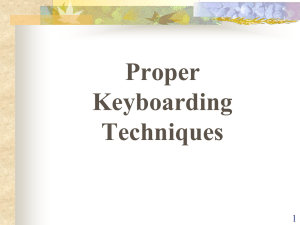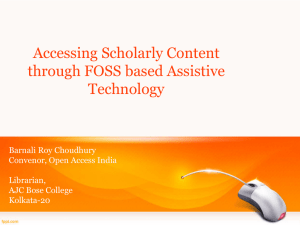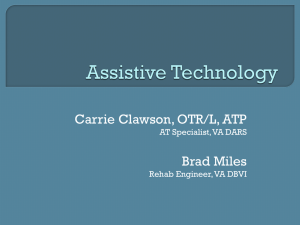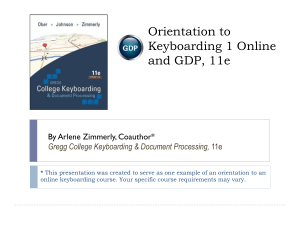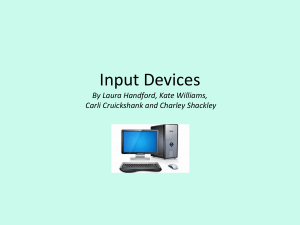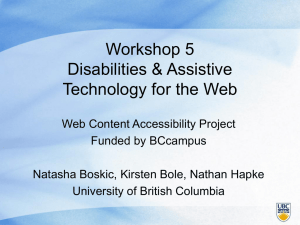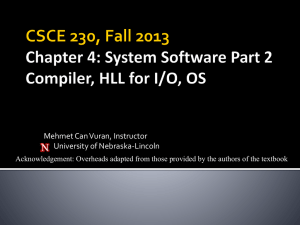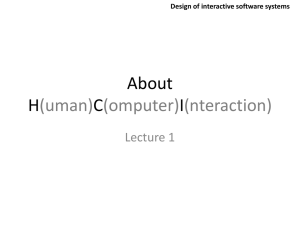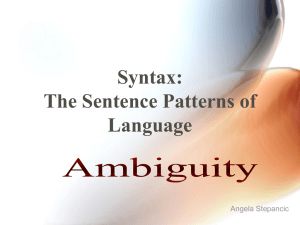ppt
advertisement
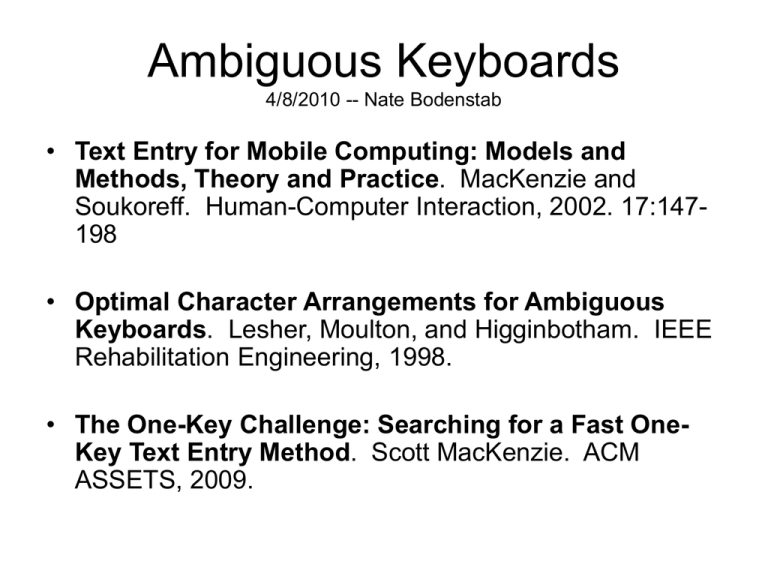
Ambiguous Keyboards 4/8/2010 -- Nate Bodenstab • Text Entry for Mobile Computing: Models and Methods, Theory and Practice. MacKenzie and Soukoreff. Human-Computer Interaction, 2002. 17:147198 • Optimal Character Arrangements for Ambiguous Keyboards. Lesher, Moulton, and Higginbotham. IEEE Rehabilitation Engineering, 1998. • The One-Key Challenge: Searching for a Fast OneKey Text Entry Method. Scott MacKenzie. ACM ASSETS, 2009. The Problem • What is the most effective method of text input? Given constraints? – Users lacking fine motor coordination to use standard keyboard – Physical device too small for full keyboard (mobile phones) • Full Keyboard (last week) – How many keys? What arrangement? Word/Char prediction? • Reduced Keyboard – How many keys? What arrangement? Disambiguation? • Stylus or Pointer – How are letters displayed and chosen? Soft Keyboard? • Speech – MacKenzie says no, but 300 WPM is tempting. – Privacy and convenience concerns. Telepathy? BCI? Big Ideas • MacKenzie and Soukoreff (2002) – Good intro and lit review of text input on mobile devices. Asks the right questions. – Present model of text input speed given keyboard layout – No mention of AAC • Lesher et al. (1998) – Model the “cost” of placing 2+ characters on the same key – Can evaluate key arrangements very quickly – Assumes character prediction model. • MacKenzie (2009) – Single button input device – Scanning ambiguous soft keyboard with word disambiguation – Four virtual keys “optimal” with small vocabulary (~9,000 words) • No one talks about spelling correction • AAC and mobile device communities should share more Two Important Groups Expert Novice Paper #1: MacKenzie and Soukoreff (2002) Text Entry for Mobile Computing: Models and Methods, Theory and Practice. MacKenzie and Soukoreff (2002) • Can text entry rates improve with… – Button arrangement? – Character or word prediction? – Different interface or modality? • Proper evaluation is critical – – – – Reproducible and generalizable (standard science) Spontaneous text generation (not text copy) Novice vs. Expert users Human trials to measure speed, accuracy, fatigue, subjective impressions of actual usage (not optimal number of clicks) • Pen or Keyboard: “which will prevail?” – Keyboard winning in 2010 – Pen has been replaced by finger (iPhone) HP95LX (1991) Apple Message Pad (1993) Palm Pilot (1996) PageWriter (2000) Cheap phone, BlackBerry, and iPhone (2008) 3-key text entry (left, right, select) 5-key text entry (up, down, left, right, select) 12-key text entry • Multi-tap – “lazy” = 5-5-5 2 9-9-9-9 # 9-9-9 – Time-out or “done” key • Two-key method – “lazy” = 5-3 2-1 9-4 9-3 • One-key w/ disambiguation (T9) – “lazy” = 5 2 9 9 # – first guess was “jazz” • WordWise (1=shift key) – “lazy” = 1-5 2 9 1-9 – 1- or 2-key w/ disambiguation Two Important Groups • Why does T9 use a unigram language model? – Uni-gram disambiguation accuracy ~95% – Bi-gram disambiguation accuracy ~97% • Novice users would see a big accuracy increase • Expert users memorize the predicted position of ambiguous words and can text without looking – “book” vs “cool” Expert Novice …although it looks like novice users are winning out in the current release (class bi-gram, recent history, etc) 18- (or 20-) key text entry • Not mentioned by MacKenzie (not invented yet) • Qwerty keyboard layout • Two letters per key • Much better disambiguation Other Ideas … Half-Qwerty keyboard One handed keyboard (Good for one-handed typing, not really for mobile devices) Other Ideas … Fold-up keyboard Chorded Keyboard MacKenzie and Soukoreff (2002) • Stylus / Pointer / Finger Input – Handwriting Recognition • Pretty accurate today, but human handwriting rate is slow (~15 WPM) • Letter input: Speed vs. Familiarity – Gesture-Based Text Input • Can be faster that letter symbols, but easy to learn? Intuitive? Unistroke (1993) – fast; more accurate; hard to learn Graffiti (1996) – Palm’s magic bullet Jot (1998) – slow; less accurate; easy to learn Convergence to Jot-like input. Graffiti 2 (2003) based on Jot. Two Important Groups Unistroke Jot Gesture-Based Text Input Cirrin (<15 WPM) Quikwriting (<15 WPM) similar to 2-key method Gesture-Based Text Input Dasher (20-30 WPM) T-Cube (21 WPM) MacKenzie and Soukoreff (2002) • Movement Minimization (WPM model) – Predicts an estimate of how efficient a keyboard arrangement will be – Model components: • Physical distance from key1 to key2 • Reaction time to find a key (expert=0) • Weighted average over all possible two-letter sequences given frequency in English – Implicit assumption of single pointer input • What about two fingers? Five fingers? – Implicit assumption of 100% accuracy (no modeling of deletions) Soft Keyboards • Brian talked about soft keyboards last week – MacKenzie and Soukoreff (2002) present a number of keyboard configurations and predicted WPM using their model – Not based on actual use! – How is distance computed on hex grid? Is this an unfair advantage? OPTI 2 Metropolis 2 Other Ideas… Projected Keyboard Ambiguous Soft (Full) Keyboard (still problems with fitting full keyboard onto mobile device) Paper #2: Lesher et al. (1998) Optimal Character Arrangements for Ambiguous Keyboards Lesher et al. (1998) Lesher et al. (1998) • Maximize power of character disambiguation (on 9 keys) – Not worrying about minimizing finger movement, user’s previous knowledge of alphabetic or qwerty arrangement, etc. • Confusion Matrix of “costs” to place two characters on same key, estimated from corpus • Can compute effectiveness of an ambiguous keyboard layout given this matrix • Still 3.0 x 1015 possible layouts… • Use “n-optimization” to find good layout – Poor man’s Genetic Algorithm • Claims to find the globally optimal solution … because convergence is so fast • Assumes we’re doing character prediction (costs matrix only works for char prediction), but word prediction is much more effective • No real human trials, results based on optimal key presses per character • Amazing that TOC does well (or others do poorly compared to TOC) • What about the standard 9-key phone arrangement? Paper #3: MacKenzie (2009) The One-Key Challenge: Searching for a Fast One-Key Text Entry Method MacKenzie (2009) • Soft keyboard with single button input – Requires scanning – Scanning unambiguous layout is slow (ie. row column scanning) • Borrows from the ambiguous keyboard literature – – – – How many soft keys? What letter arrangement? Word selection / disambiguation? Deletion and correction? • Not as many references to AAC literature… • Find optimal number of buttons and alphabet split by counting required button presses on a test corpus MacKenzie (2009) • SAK: What it does – Allows “multiple-selection” • press select key multiple times during a single scan interval • SAK does not revert to home position immediately after select key is pressed – – – – – Vocabulary size is only 9,025 words and still need 20+ word candidates Word deletion by long key-press (not really binary anymore) Faster scanning interval != faster text input ~5 WPM standard set-up ~8 WPM with “timer restart on selection” • Not sure about this one … needs comparison with immediate position restart • SAK: What it doesn’t do – – – – Disambiguation only allowed at end of word Why limit to alphabetic ordering? What about dynamic letter arrangement? Should have run parallel human trails with other methods (ie. row column scanning, Koester’s model, etc). Instead, MacKenzie just sites results from other papers with different users, setup, etc. thanks.
